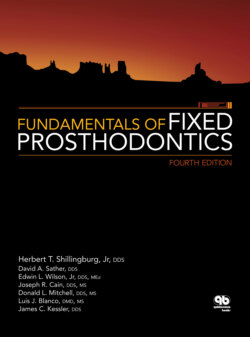Читать книгу Fundamentals of Fixed Prosthodontics - James C. Kessler - Страница 88
Composite resin
ОглавлениеThis material can be used for minor to moderate lesions in esthetically critical areas (Fig 6-6). While it can be used in the restoration of incisal angles assisted by acid etching, a tooth that has received a Class IV resin restoration ultimately will require a crown.
Composite resin has been used in the restoration of posterior teeth with mixed results. Sufficient abrasion resistance to prevent occlusal wear has been a problem. Also, unless the resin is carefully applied in small increments, polymerization shrinkage will lead to leakage and ultimately to failure. Its use probably should be restricted to small occlusal and mesio-occlusal restorations on first premolars.
An innovative approach to the prevention of root caries at the margins of restorations that extend from enamel to cementum is the application of a slurry of unfilled resin and sodium fluoride combined with laser energy.3 This approach resulted in a significantly increased resistance to acid and mechanical destruction. In another study, topical fluoride in combination with laser energy provided resistance to enamel caries.4
A technique devised to combat the problems of shrinkage and leakage is the fabrication of a composite resin inlay (Fig 6-7). This can be accomplished in the dental office, using a fast-setting gypsum cast, or in a dental laboratory. The resultant bench-polymerized inlay will have greater hardness, and the thin layer of resin used for affixing it to tooth structure will be less susceptible to significant shrinkage at the margin than a restoration that is bulk cured in situ.
